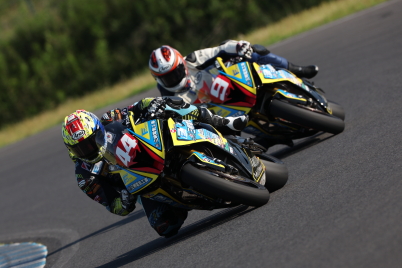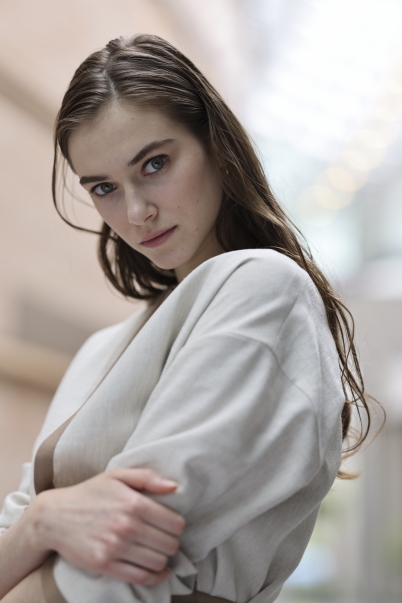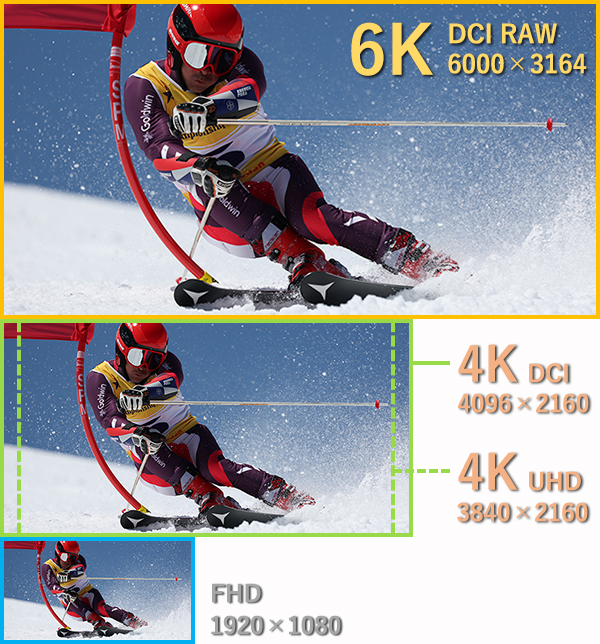EOS R3: The 7 Most Significant Features
On 14 September 2021, Canon officially announced the EOS R3. Teasers following the development announcement of the camera had unveiled fascinating specifications such as up to 30 fps high-speed continuous shooting and eye-controlled AF operations, garnering much anticipation about what else the camera would bring. And there is a lot. In this article, the first of a series about the EOS R3 and its technologies, we explore the most prominent features of the EOS R3, which is the first professional camera in the EOS R system and also the first to have an integrated grip.

#1: Blackout-free viewfinder display; 30 fps high-speed electronic burst
#2: Eye Control AF: Focus where you gaze
#3: Improved Dual Pixel CMOS AF II: Deep learning-enhanced subject detection
#4: 1/64,000-second maximum electronic shutter speed
#5: 24.1 megapixels: Achieving balance between speed and resolution
#6: In-Body IS: Up to 8 stops’ image stabilisation
#7: Video support: 6K RAW, Canon Log 3
#1: Blackout-free viewfinder display; 30 fps high-speed electronic burst
It’s not about capturing moments. It’s about capturing the best moment
For sports photojournalists, wildlife photographers, and other photographers who shoot high-speed action that occurs faster than the naked eye can catch, decisively capturing the moment is vital, and high-speed continuous shooting makes this possible.
As a professional-grade camera, the biggest strength of the EOS R3 is its high-speed continuous shooting capability. With burst shooting at up to 30 fps with its electronic shutter and up to 12 fps with its mechanical shutter (both including subject and exposure tracking), you can take your pick of the most beautiful moments.

New back-illuminated stacked CMOS image sensor, faster readouts
While the flagship DSLR, the EOS-1D X Mark III, has the faster mechanical shutter (16 fps), the EOS R3 surpasses it in terms of electronic shutter continuous shooting speed (30 fps vs 20 fps) with minimum rolling shutter distortion. This was made possible by the newly developed back-illuminated stacked CMOS image sensor, where the internal circuitry is stacked in layers behind the photodiodes (light-gathering sites) of the image sensor instead of in front of them.
With more space for the circuitry, a faster signal readout is possible, and it is quickly processed by the DIGIC X image processor. Both the EOS R3 and the EOS-1D X Mark III use that same image processor, so you can just imagine its potential!

During continuous shooting with the electronic shutter, a blackout-free* display is possible, allowing you to keep your eyes on the subject. The white frame around the display image flashes to signal that the image is captured.
*Blackouts may occur either at the start of shooting, when the built-in memory is full or when the flash is out of charge during continuous shooting and recharging is completed.
Faster sensor readout, faster electronic shutter speed
Because of how the electronic shutter works, a faster signal readout from the sensor means a faster electronic shutter speed.
When shooting fast-moving objects with an electronic shutter, one key concern has always been rolling shutter distortion, which occurs when the subject moves while the pixel readout is in progress. With a faster readout speed, rolling shutter is reduced to approximately one-fourth of that of the electronic shutter on the EOS-1D X Mark III.
Flash photography with electronic shutter: now possible
The faster electronic shutter curtain speed also makes flash photography with the electronic shutter possible—something not supported on the EOS-1D X Mark III. More scenarios to use the electronic shutter in, more opportunities to take full advantage of the maximum 30 fps continuous shooting speed.
Shutter drive modes and their maximum continuous shooting speeds*

*The actual continuous shooting speed with mechanical shutter/electronic first-curtain shutter depends on various factors such as battery type/remaining charge, temperature, built-in Wi-Fi (‘On’ or ‘Off’), flicker reduction, shutter speed, aperture value, type of lens, etc. For more information, please refer to the user manual.
Also see:
Shutter Modes & Continuous Shooting Modes: When to Use Which?
#2: Eye Control AF: Focus where you gaze
Doesn’t read your mind—just your eyes
The Eye Control AF is possibly the most unique of all the new features on the EOS R3. However, it is not new to Canon cameras: the first camera to feature it was a film SLR camera, the EOS 5 (1992). The new, improved image processing technologies, faster processing speed, and high-performance EVF on the EOS R3 give rise to new display capabilities, which in turn promise a new, improved Eye Control AF1.

How does Eye Control AF work?
The user’s line of sight is detected using the reflection of the user’s cornea created by the infrared LEDs in the viewfinder. Detection is possible even if you are wearing glasses2.
Your line of sight is indicated by an orange eye pointer consisting of two concentric circles. During the shoot, the eye pointer moves according to your gaze. To move the AF frame to the same position, simply press a pre-assigned button to ‘Start AF by eye control’, and the AF frame will move to the subject closest to the line of sight. It’s a feature that works alongside the camera’s powerful subject detection and tracking capabilities to perform AF that almost seems to read the photographer's mind.

A: EVF panel
B: Eye control sensor
C: Infrared LEDs for detecting user's eyes when wearing glasses
D: Infrared LEDs for detecting user's eyes (bare eyes)
1Calibration is recommended in advance.
2Note that the Eye Control AF may not function properly if the user wears sunglasses, mirror-type sunglasses, hard contact lenses, or bifocal eyeglasses, or due to the user’s eye conditions (narrow eyes, long eyelashes, thick eyelids) or use conditions.
#3: Deep learning-enhanced subject detection
Vehicle detection for motorsports; improved human detection
The EOS R3 uses the Dual Pixel CMOS AF II system. The “II” indicates that the system incorporates EOS iTR AF X, which conducts subject detection and tracking through technology enhanced by deep learning. Most users would be aware of the precision of Dual Pixel CMOS AF, which conducts phase detection and imaging using every pixel on the image sensor via not one but two photodiodes on each pixel. On the EOS R5 and EOS R6, Dual Pixel CMOS AF II introduced additional features such as animal face, eye, and body detection1. On the EOS R3, the subject detection capabilities of EOS iTR AF X are taken to even greater heights.
EOS R3/ RF100-500mm f/4.5-7.1L IS USM/ FL: 472mm/ Manual exposure (f/7.1, 1/3200 sec)/ ISO 400/ WB: Auto
Eye Detection AF (Human)
- Better than before at detecting eyes even if the subject is facing sideways, has shadows on their face, or is wearing heavy makeup or a face mask.
Body Detection AF
- Improved detection and tracking of subjects executing fast, complex body movements such as those in gymnastics.
Head Detection AF
- Works even on subjects wearing helmets, goggles, and other headgear that make it difficult to see the eyes and face.
The powerful subject detection algorithm behind all these was created in a short time via deep learning and involved using numerous images of the subjects to “teach” the system.

EOS R3/ RF600mm f/4L IS USM/ FL: 600mm/ Manual exposure (f/8, 1/500 sec)/ ISO 200/ WB: Auto
New Vehicle Detection AF
To better support motorsports photography, the EOS R3 is equipped with new vehicle detection capabilities2, also acquired via deep learning. It can detect vehicles and motorcycles used in motorsports, such as formula cars, GT cars, rally cars, on-road motorcycles, and off-road motorcycles. It can also detect motorcyclists, the drivers of open-type race cars, and even their helmets.
1Effectiveness varies depending on the subject. In some cases, dogs, cats, or birds may not be detected, while some animals other than dogs, cats or birds may be detected.
2The vehicle detection may not function for some subjects. Or, subjects, which are not automobile or motorcycle, may be detected as vehicles.
A new AF experience that allows you to focus on the artistic side of things
The combined capabilities of EOS iTR AF X and Eye Control AF bring about a whole new shooting experience. For example, when there are multiple subjects in the frame, you can just gaze at the subject that you want to focus on to move the eye pointer where you want. When you move the AF frame, EOS iTR AF X will detect the subject in the eye pointer’s position, lock onto it, and keep tracking it. AF operations are streamlined, leaving you to focus on other aspects such as getting the best composition at the right timing.
#4: 1/64,000-second electronic shutter
Freeze moments like never before
EOS R3/ RF70-200mm f/2.8L IS USM/ FL: 135mm/ Manual exposure (f/5.6, 1/25600 sec)/ ISO 51200/ WB: 3000K
How fleeting is the moment that you want to freeze in time? The EOS R3 can shoot exposures as fast as 1/64,000 second with its electronic shutter—a tremendous advancement made possible by the faster signal readout due to the new back-illuminated stacked CMOS image sensor and DIGIC X image processor. The slice of time in the image above is just one example.
Good for shooting in bright conditions too
If you have shot portraits with a large aperture lens in strong daylight, hoping to use a wider aperture to create beautiful bokeh, you might have experienced times when even the usual maximum mechanical shutter speed of 1/8,000 second would still lead to overexposed images. At 1/64,000 second, getting the right exposure would be less of an issue even if you don’t use an ND filter.
#5: A high-performing balance between speed and resolution
24.1-megapixels that perform way beyond the numbers

EOS R3/ RF600mm f/4L IS USM/ FL: 600mm/ Manual exposure (f/8, 1/500 sec)/ ISO 200/ WB: Auto

24.1 megapixels is sufficient for making commercial A3 size prints, but the pixel count is no reflection of the resolution and realism possible. In fact, the resolution performance of the EOS R3 exceeds that of the 30.4-megapixel EOS 5D Mark IV.*
*ISO 12233 compliant CIPA resolution chart evaluation and picture style initial conditions.
Larger photosites, excellent high ISO performance
The new back-illuminated stacked image sensor structure significantly increases the light-capturing efficiency of the pixels, which enables cleaner images at high ISO speeds. The native ISO speed of the EOS R3 when shooting stills is 102,400, expandable to 204,800.
EOS R3/ RF70-200mm f/2.8L IS USM/ FL: 89mm/ Aperture-priority AE (f/5.6, 1/100 sec)/ ISO 102400/ WB: Auto
#6: In-Body IS: Up to 8 stops’ image stabilisation
Image stabilisation that works hand in hand with the integrated grip!

A: Gyro sensor(Camera)
B: Acceleration sensor(Camera)
C: DiGiC
D: IS unit
E: Lens microprocessor
F: Acceleration sensor(Lens)
G: Gyro sensor(Lens)
The EOS R3 is equipped with an in-body gyro sensor and acceleration sensor, which detect the volume and direction of camera shake from the image sensor and compensate for it by shifting the image sensor along 5 axes of movement: horizontal, vertical, pitch, roll, and yaw. This image stabilisation is possible even when using RF or EF lenses without built-in image stabilisation (Optical IS).
On the EOS R3, the excellent processing capabilities of DIGIC X enable coordination between the camera’s In-Body IS and Optical IS. This allows more efficient image stabilisation that caters to the requirements of the focal length, achieving an image stabilisation effect of as much as 8 shutter speed stops’ equivalent.
A camera built to anticipate more handheld shooting
Portraiture often involves vertical orientation shoots, and as its integrated vertical grip suggests, the EOS R3 was also designed with portrait photographers in mind. The In-Body IS will make it easier to shoot handheld with non-IS large aperture lenses like the RF50mm f/1.2L USM and RF85mm f/1.2L USM.
#7: Video support: 6K RAW, Canon Log 3
Ample post-production possibilities to suit demanding editing requirements
In terms of video capabilities, the EOS R3 supports in-body recording up to 12-bit 6K DCI RAW 59.94p/50.00p files to its CFexpress cards. The higher pixel count and rich colour and tonal information of the 6K RAW files offer the flexibility to meet demanding post-production requirements.
As 6K video contains twice the resolution of 4K video, no image quality deterioration occurs even if the frames are cropped to 4K resolution in post-production. It is recorded using the full horizontal width of the full-frame image sensor, making it possible to faithfully reproduce the beautiful shallow depth of field of a full-frame camera, and as well as the wide, expansive feel when shooting with a wide-angle lens.

The EOS R3 supports both the 4K DCI and 4K UHD formats. 4K DCI is recorded using the full width of the image sensor, whereas 4K UHD is recorded with a crop so slight, it is barely significant at all.
4K DCI/UHD high frame rate movies are also possible at 119.88p/100.00p. For frame rates other than 119.88p/100.00p, the video is recorded at 6K (or 5.6K for 4K UHD) and downsized through oversampling. This process takes advantage of the rich 6K data to reduce moire, false colours, jaggies, and noise, resulting in higher quality 4K footage.
Canon Log 3 to support HDR productions
For HDR video production, the EOS R3 supports two gamma modes: the widely used HDR PQ gamma, and Canon Log 3, which has been a staple on the Cinema EOS system.
Canon Log 3 is effective for ensuring editing consistency in situations where the EOS R3 is used in a multi-camera system, such as in conjunction with Cinema EOS. It is also ideal for post-production processes that involve colour grading. Meanwhile, HDR PQ is an efficient option for producing HDR footage when colour grading is not necessary.

The Vari-angle LCD monitor—a great aid for video productions
The EOS R3 is the first professional EOS camera to be equipped with a Vari-angle LCD monitor. You may be familiar with how Vari-angle LCD monitor expands possibilities when shooting stills, and the same applies when shooting video. Rotate it as needed, and you can check the footage as it films, all from a more comfortable position.
If you are recording a movie in vertical orientation, the orientation information can be tagged to the file. That way, the footage will be displayed in the right orientation when opened in your post-production software.
Sample images
EOS R3/ RF600mm f/4L IS USM/ FL: 600mm/ Manual exposure (f/8, 1/6400 sec)/ ISO 3200/ WB: Auto
EOS R3/ RF100-500mm f/4.5-7.1L IS USM/ FL: 500mm/ Manual exposure (f/22, 1/60 sec)/ ISO 100/ WB: Auto
EOS R3/ RF15-35mm f/2.8L IS USM/ FL: 35mm/ Aperture-priority AE (f/5.6, 1/320 sec, EV -1.7)/ ISO 100/ WB: Daylight
--
Learn more about the EOS R3 here:
More about the EOS R system here
---
Stay tuned to SNAPSHOT for more in-depth information on the features and technologies on the EOS R3!
Receive the latest update on photography news, tips and tricks.
Be part of the SNAPSHOT Community.
Sign Up Now!





































.jpg)


